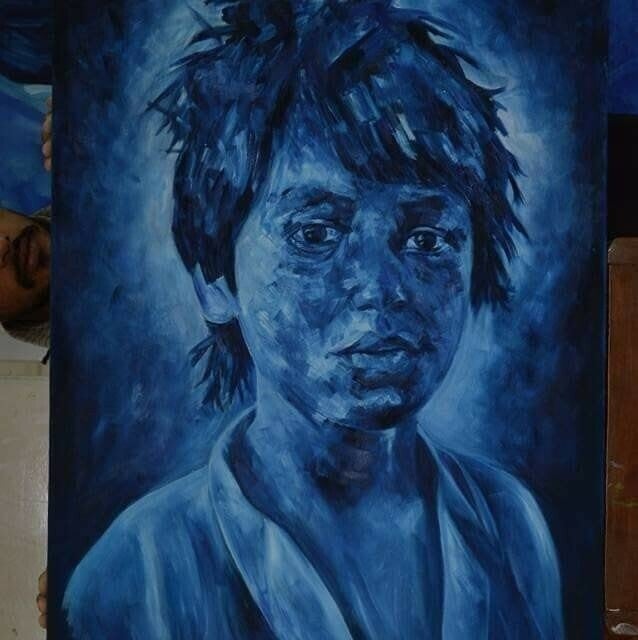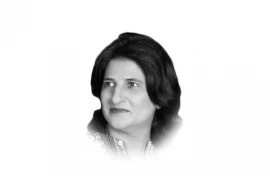
When an artist finds their long-lost paintings hanging in a TV drama, one might think it's a scene straight out of fiction. For Ghotki-based artist Seffy (Safdar) Soomro, however, it was a bizarre reality. Years after being informed by Frere Hall that his artwork had gone "missing", Soomro saw them casually gracing the set of episode 17 in Kabhi Main Kabhi Tum, a local TV drama. The artist then took to social media on September 17 to tell his story.
This peculiar revelation kicked off an inquiry, which concluded in the most anticlimactic way possibleby blaming a "misunderstanding", as is reported by multiple news outlets. An inquiry, led by the Directorate General of Culture Sindh, released a report on Monday evening that, predictably, explained everything away as a harmless mix-up.
Chinoy's take
Earlier this week, two-time Oscar winner Sharmeen Obaid Chinoy weighed in on the controversy, criticising the inquiry's impartiality. "Why doesn't the Sindh government establish an independent committee with true authority, one that can conduct impartial investigations?" Chinoy asked pointedly. She urged the authorities to take more meaningful action in protecting Sindh's rich artistic and cultural heritage.
Her frustration stems not only from Soomro's ordeal but also from broader issues with cultural preservation in Sindh. Chinoy has previously voiced concerns about the Karachi Museum, where, according to her, "rare artefacts are being sold and replaced with replicas." The state of art and culture in Sindh, she suggested, has long been neglected by those in power.
Meanwhile, Big Bang Entertainment, the production company behind Kabhi Main Kabhi Tum, was quick to wash its hands of the matter. The company issued a statement, clarifying that it had merely rented the location and props for the drama, expressing sympathy for Soomro's predicament while advising him to take up the matter with Frere Hall.
An artist's grievances
Sindh Culture Minister Syed Zulfiqar Ali Shah had ordered the investigation, which confirmed Soomro's paintings had been sitting in Karachi's Frere Hall all along, despite their "missing" status. A two-member committee was formed to look into this mysterious vanishing act, comprising the director generals of culture and antiquities. Their findings? The paintings had never actually disappearedthey'd simply been shuffled around for exhibitions over the years.
Of course, this neat little explanation didn't sit well with Soomro. "I was lied to," Soomro accused. "I was told my paintings were lost, only for them to be reused for profit." Strong words, but understandableimagine being told your prized work was gone, only to spot it, years later, as background décor in a show.
The report, however, had a different take. It stated that Soomro hadn't shown much interest in reclaiming his paintings after the exhibition. This "misunderstanding", according to the report, was all down to miscommunication between the artist and Frere Hall's management.
Soomro slams inquiry
Soomro wasn't having it. Earlier this week in a Facebook video, he rejected the report outright, calling it biased and self-serving. "The Sindh government is doing exactly what I had anticipated because the departments, the DGs, are all working under them. They shouldn't have been the ones investigating this matter to begin with. It should have been some third party. I do not buy this report at all," he vented.
He was particularly infuriated by the confirmation that his artwork had indeed been at Frere Hall all along, reused without his consent. "Thank God, whatever I had said has proven correct. My paintings were, in fact, at Frere Hall. They have admitted that. They have also admitted that they kept using my paintings for various exhibitions. This means that they had been receiving money all this time from some drama, exhibition, or event by misappropriating my work." Soomro pointed to a fundamental violationhis artwork should have been properly stored after the exhibition ended, not left to random events without his knowledge.
"If no one came to collect my work after the exhibition, it should've been packed and stored," he argued. The fact that it wasn't packed upjust left hanging as a convenient backdrop for future exhibitionswas, in his eyes, gross negligence. And, of course, it doesn't help that these exhibitions seemed to involve making money off his intellectual property without his consent. Soomro also said the pieces were part of his thesis for the University of Sindh's Fine Arts Department.
Soomro suspects he's not the only artist whose work has been mishandled. "Just because I raised my voiceand it was heard everywheredoesn't mean I'm the only one this has happened to." He called out the report for favouring Frere Hall and vowed to continue his fight for justice. "I will not settle for this. God is watching," he declared ominously, promising further action.
His grievance touches on a larger issueif his artwork could be used without permission, what's stopping this from happening to other artists? Soomro seems to think other creatives have likely suffered in silence, but few have spoken up. His case, after all, was only thrust into the spotlight when his paintings were caught on camera in a drama.




1721030563-0/BeFunky-collage-(8)1721030563-0-165x106.webp)

1724399654-0/iPhone-16-(1)1724399654-0-270x192.webp)



1729329625-0/Untitled-design-(8)1729329625-0-270x192.webp)







COMMENTS
Comments are moderated and generally will be posted if they are on-topic and not abusive.
For more information, please see our Comments FAQ